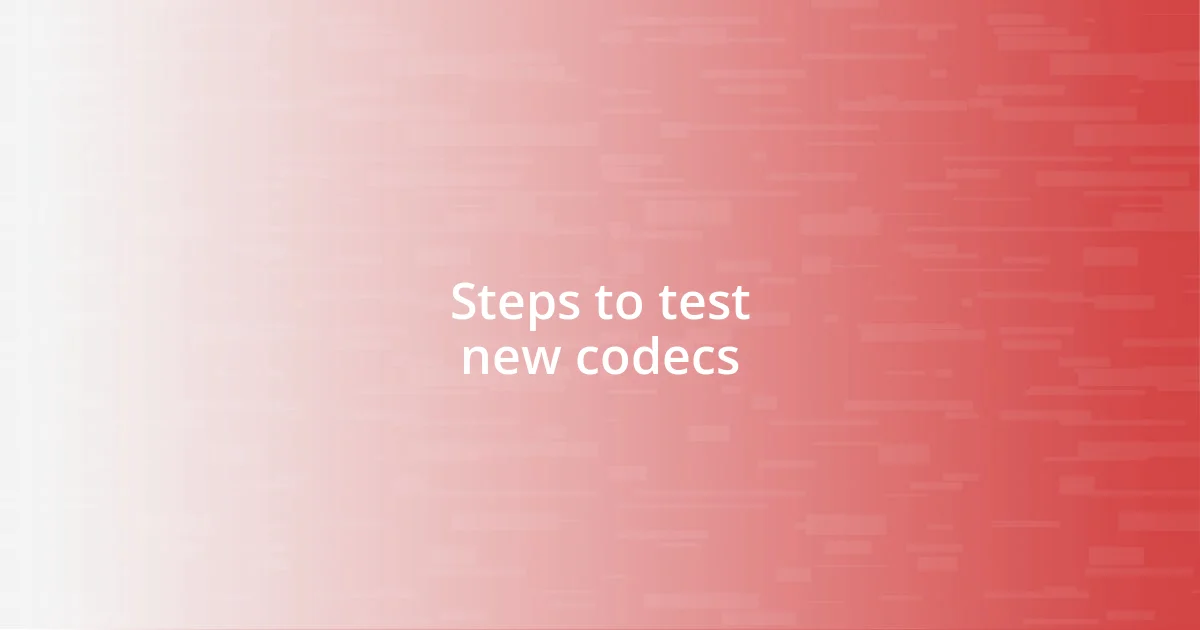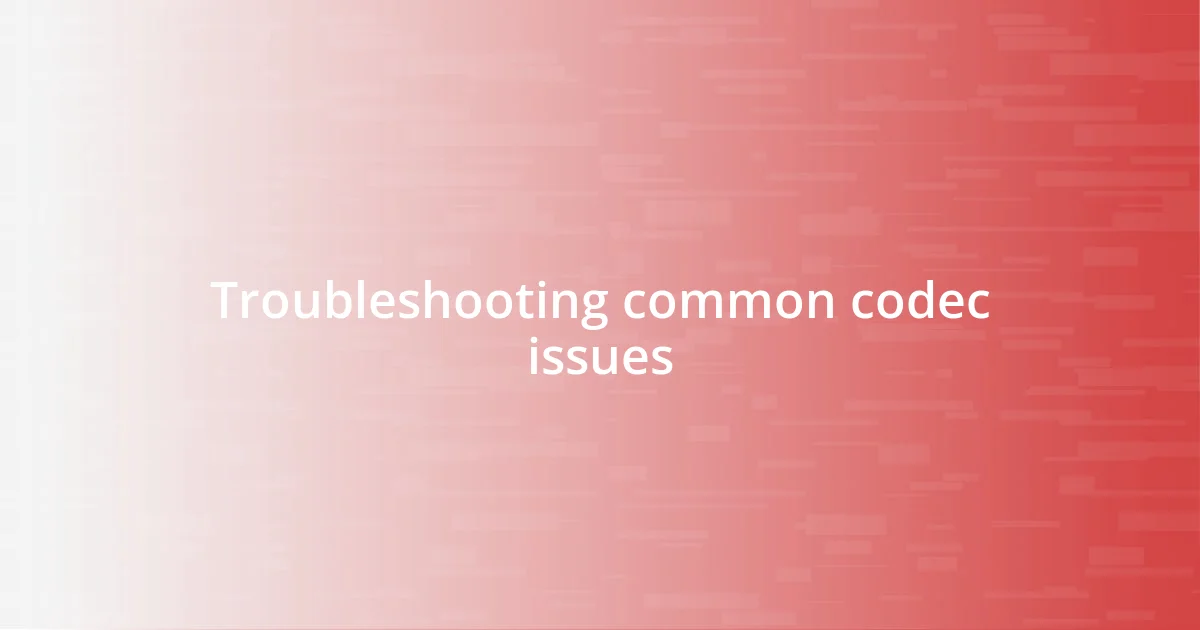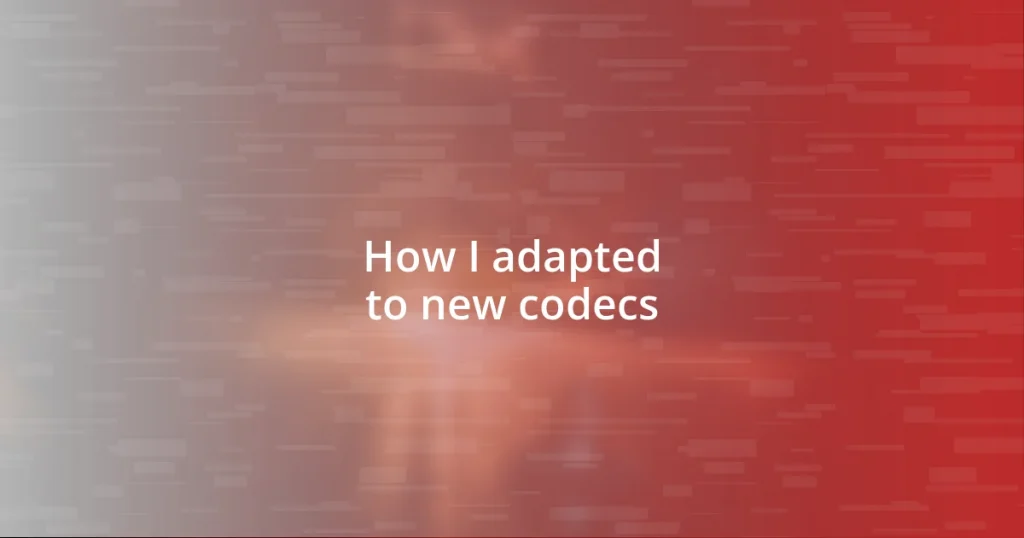Key takeaways:
- Understanding and selecting the right codec is crucial for balancing quality, file size, and compatibility in digital media projects.
- Evaluating codec performance metrics such as bitrate, compression efficiency, and latency is essential for optimizing editing workflows and enhancing viewer experiences.
- Thorough testing, audience feedback, and troubleshooting common issues, such as sync problems and compatibility, are vital for successful codec implementation in projects.

Understanding codecs and their purpose
When I first delved into the world of codecs, I was struck by how crucial they are for digital media. A codec, which stands for coder-decoder, compresses and decompresses digital files, ensuring that video and audio can be transmitted efficiently without sacrificing quality. Have you ever wondered how your favorite streaming service delivers such high-quality content without requiring massive amounts of bandwidth? That’s the magic of codecs at work.
As I navigated various codecs for different projects, I found each one has its unique purpose and strengths—like how H.264 balances quality and file size, making it a go-to for many. The technical nuances can feel daunting at times, but understanding how codecs function not only enhances your digital experience but also aids in making more informed choices when editing or sharing media. Every time I successfully tweak a codec for a specific task, I feel a sense of accomplishment, knowing I have unlocked better performance and more immersive experiences.
Sometimes, I reflect on the frustration I felt while grappling with audio sync issues in videos due to improper codec selection. It can feel overwhelming at first, but these challenges are invaluable learning experiences. They remind me that mastering codecs is not just about the technicalities; it’s about creating a seamless experience that resonates emotionally with viewers, pulling them into the story we’re trying to tell.

Identifying key codec types
When I began pinpointing key codec types, I discovered that each codec serves a specific niche. For instance, when I first encountered HEVC, I was amazed by its ability to compress files without losing much quality, perfect for those high-resolution 4K videos. It’s like finding the perfect ingredient that elevates a dish—suddenly, everything tastes so much better, and you can share those expansive visuals without overwhelming storage.
One of the more surprising moments in my codec journey was learning about the differences between lossless and lossy codecs. Initially, I thought that lossless meant it would always retain every bit of quality, but after a few experiments, I found that lossy codecs like MP3 have their place too—especially for music where storage efficiency is essential. It reminded me of decluttering my digital life, where sometimes, it’s okay to let go of a little quality for the sake of convenience, much like my minimalist approach to physical possessions.
As I explored various codec types, I started to see patterns in how they fit into specific workflows. This realization helped me streamline my editing process, particularly when I was working on a short film project and needed to deliver it online fast. Selecting the right codec became as crucial as choosing the right shots. It’s rewarding to know that with the right codec, I can provide an optimal viewing experience, sparking joy in viewers who appreciate the craft that’s gone into the final product.
| Codec | Type |
|---|---|
| H.264 | Lossy |
| HEVC | Lossy |
| FLAC | Lossless |
| AAC | Lossy |
| PNG | Lossless |

Evaluating codec performance metrics
When it comes to evaluating codec performance metrics, I quickly learned that there are several key factors to consider. For instance, encoding speed is often crucial, especially during tight deadlines. I’ve found myself in situations where a slower codec could mean the difference between getting a project in on time or facing disappointment. It’s a stressful moment when you realize you need a codec that can balance speed with quality and it’s something I keep in mind for future projects.
Here are some essential performance metrics to focus on when evaluating codecs:
- Bitrate: Higher bitrates usually mean better quality, but they also enhance file size.
- Compression Efficiency: How well does the codec reduce file size without significant quality loss?
- Latency: Important for live streaming applications; lower latency ensures smooth interaction.
- Visual Quality: Subjective, but essential—how does the codec perform in real-life scenarios and different resolutions?
- Compatibility: Which platforms and devices support the codec? I remember being frustrated by a codec that worked beautifully on my computer but failed to play on my phone.
Digging deeper into codec performance, I became aware of the importance of testing in real-world scenarios. In one of my projects, I decided to test various codecs for an animated short. The difference in visual quality between H.264 and HEVC was eye-opening; while HEVC offered significantly better results for the same file size, the encoding time was considerably longer. This hands-on experience reinforced my understanding of codec performance metrics and their practical implications. It’s about more than numbers—it’s about making choices that elevate the viewer’s experience without sacrificing my own workflow efficiency.

Steps to test new codecs
Testing new codecs is a multi-step process that I’ve found to be both critical and fascinating. First, I always begin by setting clear objectives for what I want to achieve, whether it’s file size reduction, maintaining video quality, or optimizing for streaming. This step is kind of like defining the purpose of a recipe before you start cooking. What am I trying to accomplish here? When I answer that question, everything else falls into place.
Next, I dive into hands-on testing. I typically create a variety of video samples that represent different scenarios—think of it as gathering a set of ingredients for a dish. While testing, I pay close attention to each codec’s performance under real conditions. In one instance, I took a high-paced action sequence and compared H.264 with a newer codec. The disparities in visual performance were enlightening, and I felt a rush of excitement as I unraveled which codec truly excelled under pressure. It’s like pulling back the curtain on a magic trick; revealing how each codec behaves brings a sense of clarity and engagement.
Lastly, I document everything meticulously. I make notes of each codec’s strengths and weaknesses, much like jotting down my cooking adjustments for future reference. I often ask myself, which codec provides the best quality-to-file size ratio? Logging my observations helps me make informed decisions later. It’s amazing how this process transforms each experimentation into a resource for my future projects, enhancing not only my technical expertise but also my creative instincts. Isn’t it gratifying to learn from each codec trial and apply those insights to elevate our work?

Implementing new codecs in projects
Implementing new codecs in a project isn’t just a technical detail; it can dramatically alter the project’s success. I remember when I integrated AV1 into a video streaming platform. Initially, I was intimidated by its complexities, but the potential for drastically reduced bandwidth use while enhancing visual quality really drew me in. The moment I saw the seamless playback on various devices, I felt an exhilarating sense of accomplishment—it was like discovering a hidden treasure.
As I worked on implementing the codec, I encountered compatibility challenges. It’s almost humorous how I underestimated the importance of this aspect. I vividly recall a situation where I released a video that looked stunning on my computer but promptly pixelated on users’ devices. How could I have overlooked that? This taught me the hard way that thorough testing across different environments is essential. It’s a learning curve that, while frustrating, only deepened my appreciation for thoughtful implementation.
I also learned to prioritize the feedback from my audience. After launching a new project with the codec, I solicited input from viewers, and their reactions were telling. Many praised the improved quality, but some mentioned buffering issues. This realization hit home: implementing new codecs isn’t just about tech specs; it’s about enhancing user experience. Crafting a project involves constant iteration, and being open to feedback becomes a vital part of the process. How often have we overlooked this crucial connection with our audience? It’s one of those pivotal moments that truly shapes our work and growth in this field.

Troubleshooting common codec issues
When I first began working with codecs, I stumbled into common issues that made my head spin. One day, while encoding a video, I noticed that the audio was completely out of sync. I spent hours trying to troubleshoot it before realizing I hadn’t accounted for frame rate discrepancies. I learned the hard way that aligning your audio and video frame rates is crucial. Has anyone else faced that frustrating moment where everything seems fine on the surface, but there’s a hidden detail causing chaos?
Another challenge I encountered was when a video refused to play on certain devices. I vividly remember the sinking feeling when I realized my project, intended for a broad audience, was hindered by codec compatibility. After some research, I realized that not all platforms support the latest codecs. This experience taught me the importance of cross-platform testing. Have you ever launched something only to find it doesn’t work as expected on your favorite device? It drives home the point that understanding your audience’s tech environment is vital.
The most revealing experience I had with codec issues was during a live-stream event. Mid-broadcast, the video lagged terribly, and my heart raced as I frantically checked settings. In that moment, I realized the importance of a solid internet connection in relation to codec performance. I learned to double-check network stability and have backup plans in place before critical events. It’s moments like these that remind us—what good is a stunning codec if it can’t deliver when it matters most?













